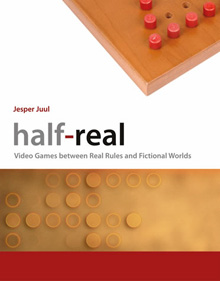
I am happy to announce that my book, Half-Real: Video Games between Real Rules and Fictional Worlds has now been published by MIT Press.
Half-Real is an attempt at creating a basic theory of video games: In the book I discuss what video games are and how they relate to non-digital games, how players learn to use a game, how players imagine the world of a game, and why video games are fun.
Half-real is a book on video game theory, but it is generally readable. As for method, the book is an eclectic mix of theories on games, film and literary theory, computer science, and psychology.
In addition to the introduction, the book has five parts:
Classic game model: Chapter 2 presents a classic game model, whose contents are inspired by a number of previous writers on games. The model describes how games have been constructed in a specific historical period, while allowing for the possibility that games can change and develop from an older model.
Rules: Chapter 3 is inspired mostly by discussions in the game development community, and attempts to apply some terminological and methodological stringency to the discussion of rules in games. In order to describe games as rule-based systems, I draw on computer science, on the sciences of complexity, and on economical game theory. In order to describe the player’s use and experience of the rules of a game, I draw on Marcel Danesi’s writings on puzzles (2002), some game design theory, and some cognitive science.
Fiction: The goal of chapter 4 is to provide an account of the fictional aspect of games, but an account that covers the spectrum from abstract games, to games with incoherent fictional worlds to games with detailed fictional worlds. To be able to discuss this spectrum, the theory of fictional worlds is employed.
Rules & Fiction: Chapter 5 is the synthesis of the two perspectives of rules and fiction and discusses their interactions by way of multiple detailed examples.
Chapter 6 sums up the points of the book and provides some further perspectives.
The book is based on numerous game examples, with more than 100 screenshots from the past 40 years of video games.
The book’s companion website is up at http://www.half-real.net.
The website also contains A dictionary of video game theory, an expanding dictionary of video game theory terms.
Though Half-Real shares its title with my PhD work, this book is brand new, all together nicer, more readable, more fun, and just better.
A lot of work went into this book, so I hope you like it!

